
|
 |
Kitaplar » AQUACULTURE » Sea Bream Breeding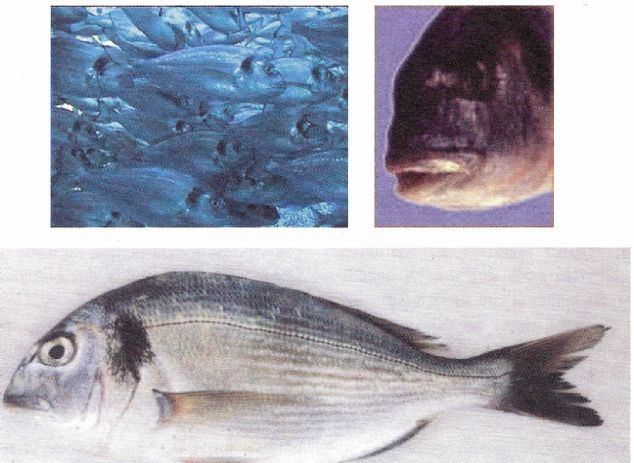 GIELTED SEA BREAM BREEDING Sea bream is a very popular fish species, especially in the Aegean Region. Therefore, there has been a constant interest in its cultivation. As a result of the studies that started after the 1980s, very successful breeding practices have been made in our country. It is also a very valuable fish in Mediterranean countries such as Greece, Italy and France. For this reason, breeding studies have shown significant progress in these countries. The point reached in our country as a result of intense efforts in this regard is pleasing. Since 2012, the amount of sea bream grown in our country is around 35-40 thousand tons. These developments are expected to increase even more. (For 2019, cultured gielted sea bream production was 99730 tons and for sea bass it was 137419 tons ) BIOLOGICAL CHARACTERISTICS OF BREAMS The place of sea bream in zoology science; Subclassis: THE LIFE OF BREAM IN NATURE Sea bream is a common species from the English coast to all Mediterranean regions. In our country, it is mostly found in the Southern and Aegean Regions. In fact, most of the Istanbul fishermen do not know this fish very much. For this reason, its price is higher in the Aegean than in Istanbul. Although this fish is known as "Alyanak" in Istanbul, as a result of the increase in its cultivation, it has been known as Sea Bream in Istanbul and our country market. It is a benthic species and eats at the bottom of the sea. Growth rate may vary depending on the regions. Puppies born in the Aegean Region between December and March pass 30-50 grams in the spring season and 100 grams at the end of the first summer season. The 30-50 grams of these fish are called thin lidaki. 100 gr ones are called lidaki, those between 100-180 gr are called coarse lidaki, those weighing 200 gr and more are called sea bream. After the age of two, the fish will have a portion weight of 300-400 grams. Fish of this size are sold at the highest price. Significant amounts of sea bream are produced in the Aegean region, especially in the lida and coarse fish. In breeding conditions, it is aimed to give fish to restaurants during the tourism season by trying to reach 250-350 grams from the middle of the second summer season. Sea bream fish like areas called rake. In general, they are in the bottom fish group. They come to the shores at certain times of the day and look for food. For this reason, they can hunt abundantly in shallow waters in the morning and evening. Sea bream fish shows optimum development at a temperature of 22-25 degrees. It can survive between 6-32 degrees. They do not like very cold water and die in extreme temperature changes. For this reason, they leave the kiddles in the autumn season. They can withstand 10-40% salinity. It is not good for the salinity to drop below 10%. For this reason, in kiddles with large amounts of fresh water, if the salinity is too low, they want to leave. In terms of their anatomical structure, their bodies are high and flattened from the sides. Pectoral fins are located on the sides. There are more than 5 rays in the pelvic fin. The dorsal fin is forward and hard-rayed. The body is covered with scales up to the head and the scales are hard. The lateral line is clearly formed. Its mouth and teeth are hard and can break even crustaceans. Thanks to their strong teeth, they can break and eat small mussels and crabs. Little crab cubs are among their favorite foods. Fishing with crab gives very successful results. Fishing with this species is very enjoyable. They like to live at a depth of 5-25 meters. As the fish get older, they prefer to live deep. For this reason, larger fish are caught less in fish ponds. They do not approach the shores when they are two years old. They are not very willing to enter kiddles either. They prefer deep places, especially after the age of 3. 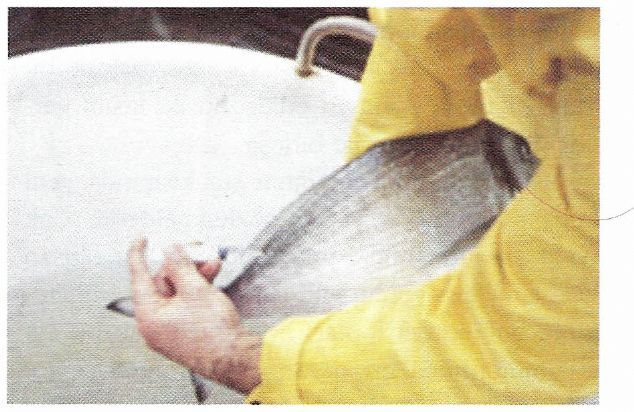 Top: Injecting hormone into the rootstock of the bream for ovulation.
Large bream fish can produce between 500,000 and 1,000,000 eggs in their first breeding season. Egg yield is higher in the natural environment. Continuous egg retrieval is easily achieved under hatchery conditions. In the natural environment, spawning takes place at depths of 5-25 meters. Ovulation occurs mostly at 14-19 degrees. Therefore, as you move north, spawning takes place in the summer in England. In the south and in the Mediterranean, December is the spawning season. The age of reaching sexual maturity in fish is two. During this period, it is observed that the fish are generally male. From the 3rd and 4th years of age, it is seen that fish transform to femininity. Although it is unlikely that fish will change sex depending on environmental conditions, it is possible. Sea bream fish is a species that has attracted attention and has been raised in the last 20-25 years. It can be observed from time to time that the species can change gender at any time. Most of the old fish caught from nature are female, and in the two-year-old fish, male individuals are very high. All this means that the fish are mostly female after the age of two. In terms of resistance to salinity, they are not as durable as mullet and perch fish. Marine mullet and perch fish can enter freshwater or slightly salty lakes, but sea bream fish are observed not to enter. For example, sea bream fish are not caught in Bafa Lake although sea bass and mullet are caught. Because mullets and perch can enter Bafa Lake by following the road of the Menderes River, which contains fresh water. Sea bream fish cannot reach the lake by the same route. However, in recent years, as a result of the decrease in the amount of fresh water entering Bafa Lake, the salinity of the lake has increased and it has been observed that sea bream fish are also living. As a conditioning factor, large differences can be seen between fish of the same size. Fish in nature are weaker and leaner in the spring season. Recently, they reach their maximum. The period when the weight is highest is the period when the gonads are most developed before ovulation. 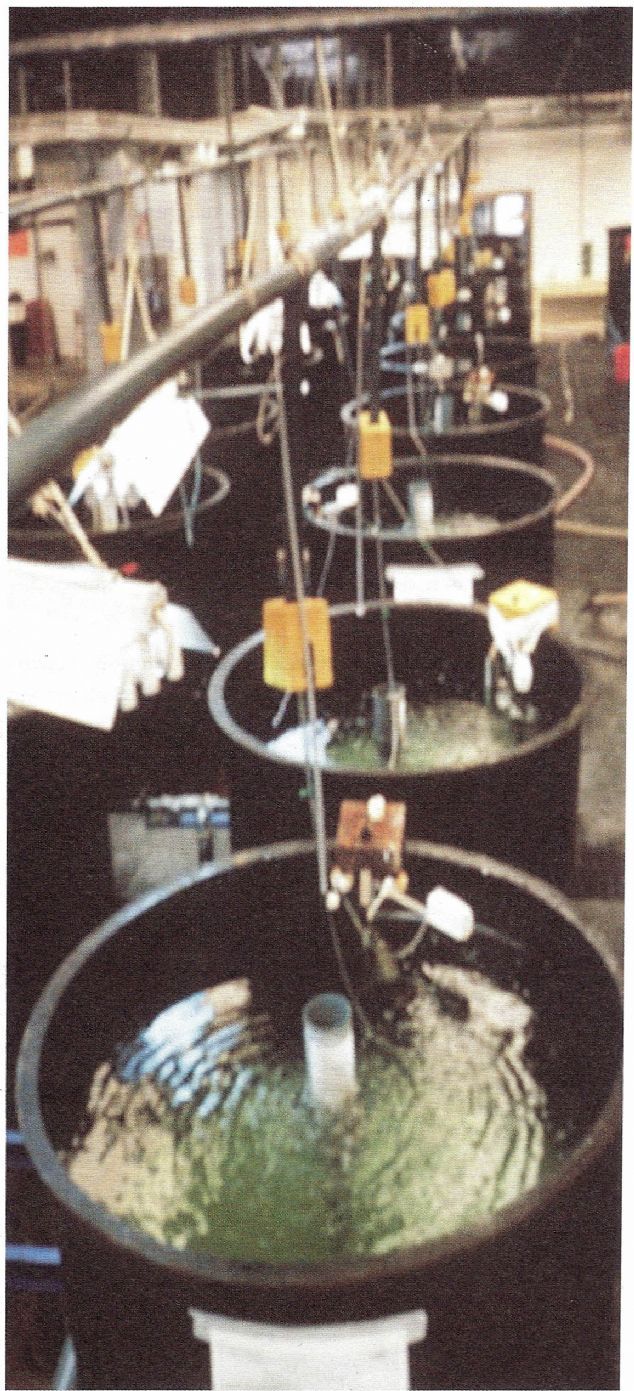 Sea bream larva production tanks BREAM FISH FARMING Reproductive Physiology in Sea Bream
We have mentioned above that sea bream fish show bisexual characteristics. In a study conducted at 23 degrees, it was found that there was no cellular and formal differentiation in the gonads of 4-month-old bream. The formal differentiation begins in the 5th month. At the beginning of this period, connective tissue begins to develop in the back and abdomen of the sex tissue. There is a central void in the middle. The formation of ovaries on the back of this part and testicles on the abdomen will begin. However, this differentiation is very difficult to distinguish. These two parts merge with germinal cell nests. In the 8th month, a newly formed egg structure is observed on the back of the reproductive organ. Avigel lamellae (lobes with egg cells in the ovary) formed by the fusion of many egg cells are seen. However, this month, the egg cells undergo deformation and remain in an ovugel lamellar bed at the edge of the gonad center. There are more spermatogoniums (sperm parent cells) in the lower part of the gonad compared to 5 months old fish. In the 9th month, the upper avigel lamellae appear to be empty and the degeneration of the egg cells is complete. Egg cells are stuck in a bed. In the tenth and eleventh months, sperm cell activity develops and continues in the lower part of the gonad. The sperm animals (spermatozoids) in the testicular tubes set out from the sperm parent cells and settle in the section where the germinal cells are located. The testicular part begins to surround the upper part of the gonad and grows. The spermatozoid duct (sperm canals) is located in the elongating center and is the part where spermatozoids are collected. It is between the ovary and testicles. 1-2 female germinals are trapped at the edge of the cell bed center. These are ovogonia (egg main egg cell). Egg cells will perform the primary vitellogenesis event by meiosis. The twelfth month is the first season of breeding. At this age, all fish show male characteristics. In the lower part of the gonad is a mature testicle (male reproductive organ). However, it has a low RGS value. Sperm production occurs in the tubes filled with spermatozoids. No change is observed in the female part of the gonad and it shrinks thoroughly. Between the thirteenth and sixteenth months, gender conversion begins. In the spermatozoid part of the gonad, the gonads are discharged and the resting phase begins. There are only spermatogonia in the testicular tubes. In the ovary (ovary), egg cells begin to multiply rapidly. Primary oocytes (Primary egg cells) rapidly enter a period of previtellogenesis. At the sixteenth month, the ovary covers 80% of the gonad. In the population, transformation occurs at a rate of 80% in the seventeenth month. In the upper part, egg cells complete previtello genesis and pass to vitellogenesis. At the same time, the lower sperm main cells die and degeneration begins. In the second period of reproduction, at the twenty-three and twenty-fourth months, females have a mature ovary. In the lower part is a degenerated male reproductive organ. For the remaining 20% of the population, gender conversion stops. The egg cells in the upper part of the gonad break down and the upper development gets stuck in the lower development. Under natural conditions, rootstocks showing female characteristics at two years old are intersex at three years old (functionally neither female nor male). If these individuals are given a hormonal intervention, they will act as men. Otherwise, they show female characteristics at the age of 4. These gender transformations vary according to the ratio of female to male in their population. When sperm production is completed in male individuals of sea bream fish, preparation continues for the maturation of the egg cells and the laying of the eggs in most of the female. It is possible to obtain sperm from sea bream males between October and March.
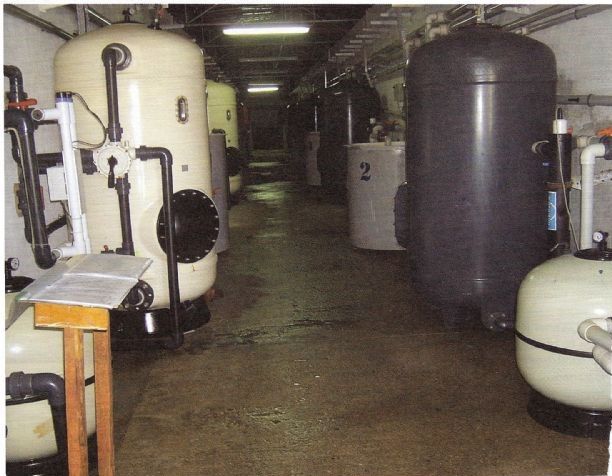 Closed circuit systems are successfully handled in our country in the production of sea bream and sea bass larvae. The picture shows the closed circuit systems in the "KILIÇ Fishing" hatchery.
EGG AND SPERM SELECTION IN ROOTSTOCKS The development of the egg cell in sea bream occurs in 7 stages.
1. Primitive egg cells are very small and are between 8-12 microns in size. Cells reproduce by mitosis. 2. A follicle (where the egg cells are fed and hormones are synthesized) has formed around the egg cell. This makes up the second layer of the cell. 3. The size of the cells reaches 40-200 microns. It is completely surrounded by the phallus. 4. Vitellogenesis has begun. Egg diameter is between 200-350 microns. The accumulation of fats in the cytoplasm has begun. 5. Cytoplasma is full of oil droplets. Vitellogenesis is accelerated. Egg size is between 300-350 microns. 6. The yolk layer pushes the oil drop towards the edge of the cell where the second ring begins to form. Substances that play a role in protein synthesis and nutrient accumulation adhere to the nuclear membrane. Egg diameter is about 600 microns.
7. Vitellogenesis is complete. Egg diameter is between 700-800 microns. Core substances started to be pulled towards the center. Micropile hole was formed during this period. The egg remains in this state for several weeks without any change.
When the appropriate conditions are provided, ovulation (the egg cell being ready to be released from the gonad to the outside environment) occurs with the contraction of the muscles in the follicle. If biotic and abiotic conditions are not suitable, eggs are reabsorbed.
Spermatozoa (sperm animals) are formed as a result of Spermatogoniums (Sperm parent cells), Spermatogenesis (sperm cell formation in testicles) within spermatogenic units. This process starts with the rapid mitosis and proliferation of spermatogonia. This period is called Primary Spermatogenesis. After this period, Secondary Spermatogenesis occurs where the first meiotic division occurs. Secondary Spermatocytes are formed as a result of Secondary Spermatogenesis. Sperms collected in testicular canal spaces and waiting until appropriate conditions are formed, become ready to be expelled with the effect of gonadotropin.
ROOTSTOCKS and EGGING
2-6 year old bream is used as rootstock. Individuals that can be rootstocks are raised in their youth by selecting them. They can also be caught with fishing line and pareketa from the natural environment. Eggs can be taken from the rootstocks naturally, free and with intervention (Hormone Applied-Decalage) as well as milking method. Spermatogenesis (Sperm Cell Formation in Testicles) is completed in males kept in a breeding environment. Since oocytes (egg cells) in females only develop in the last stage of vitellogenesis and subsequently undergo rapid degeneration, the use of rootstocks captured from the natural environment gives better results. In the following years, in order to obtain successful results from the breeding studies, techniques that will ensure that eggs can be obtained from fish grown under human hands should be developed.
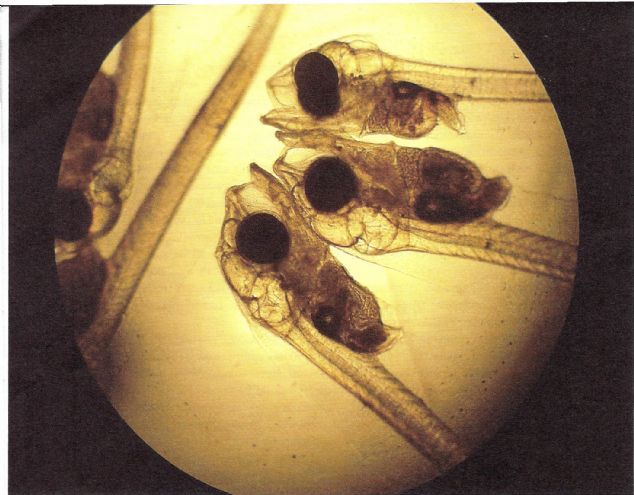
Bream females lay their eggs consecutively. They lay eggs almost every day for a period of 3-4 months, giving an average of 20,000-30,000 eggs for each kilogram of body weight. Thus, the egg yield of bream females can reach 2-3 million eggs in proportion to their body weight. Rootstocks are stocked in 4-7 m3 tanks with a density of 10-15 kg. To obtain eggs out of season, tanks should be equipped with a system where lighting and temperature can be controlled. This process is called kelage work. With this study, it is possible to get eggs from fish out of season. When stocking, the female-male ratio is adjusted as 1: 1, 1: 2 or 2: 3 kg depending on the condition of the rootstock fish. Fish should be fed 1-3 times a day with dry pelleted feed based on squid meat at 1-1.5% of their body weight (kg). In addition, they can be fed with fresh mussels, cuttlefish and squid meat. The feeds given should consist of 50-55% protein and 10-15% fat. Oils should contain at least 5-3% HUFA (highly unsaturated fatty acid) and should be of the essentially 22: 6 n-3 (docosahexaenoic acid) type. This diet should be applied on rootstocks at least 1-2 months before starting to spawn. The water temperature should be kept between 16-18 degrees during the spawning period. When the spermatogenesis stage is completed in males, preparations continue for the maturation of the oocytes and the laying of eggs in most females. The difference between sperrnotogenesis and oogenesis (egg cell formation) can be closed by accelerating the development of oocytes with the use of hormones. HCG hormone activates the immune system in sea bream. Therefore, measurement techniques for the maturation gonotrophine of Sea Bream with homologous radioimmunoussay (RIA) system have been developed. When using RIA, female bream sometimes do not give eggs. This is because Gth accumulates in the pituitary but does not enter the blood circulation system. This event demonstrated that gonadotropin releasing hormones or analogs (GnRH or GnRHa) can be used to initiate ovulation. As a result, the work has shifted to polypeptides and polymer-based production. These systems are very effective for long gonadotrapin (Gth) secretion and successful ovulation in bream. In studies conducted on sea bream fish, HCG is used as 800-1500 IU / kg and GnRH 1- 20 mg / kg. It has been observed that the 1 mg / kg hormone application in the bream prolongs the ovulation period and reduces the anomaly. In females, administration of 7.5 mg / kg GnRH with a single injection has been shown to induce ovulation over 80%. With optimum environmental conditions, spawning can take place all year round. Ovulation starts 48-72 hours after hormone administration. Ovulation may occur at different times of the day within a few days after hormone administration. About a week after ovulation begins, the time of ovulation of females in the population coincides with the same period. Ovulation usually occurs at sunset and at intervals of twenty-four hours. Since the population that will lay eggs is very sensitive to stress, stress factors should be eliminated during ovulation. Care should be taken not to make noise around. During the ovulation season, some of the oocytes begin the vitellogenesis phase, while others go through the final stages of vitellogenesis. Therefore, vitellus material is found in the ovaries for a few months of the year. During the 3-4 month spawning period, female bream bream lays a total of 0.5-2 kg eggs per body weight. This value is equal to 0.5-2 times their body weight. This long and difficult egg production can only be supported by high quality and energizing foods. The content of the food given to sea bream rootstocks directly affects the quality of eggs and larvae. The quality of the live eggs is determined by the amount of eggs, the number of fat droplets, larvae hatching rates and the percentage of normal larvae. This situation is only possible if the rootstocks are fed with high quality feeds.
EGG CHARACTERISTICS AND EMBRYOLOGICAL DEVELOPMENT
Live eggs are 0.9-1 mm in diameter and transparent. Normally, eggs containing a single drop of oil show pelagic properties. The egg membrane is transparent and thin. Micropile hole is approximately 14 microns in size. Lifeless or unfertilized eggs become opaque within a few hours and settle to the bottom of the tank. Single and double collector systems can be used to collect live eggs from the tanks. In the double system, waste materials are collected in the first collector. The water that passes here comes to the other collector and collects the eggs. The eggs provided should be placed in egg incubator systems (incubator tanks) at the same temperature as the environment in which they were collected. The temperature difference should not exceed ± 0.5 degrees. Egg hatching temperature should be between 16 and 18 degrees. Natural seawater salinity should be used in incubation systems. Eggs are placed in these systems at an average of 1.500- 2.500 pieces / lt. No light is used during the incubation period. 40-60% water change per hour is applied in the tanks.
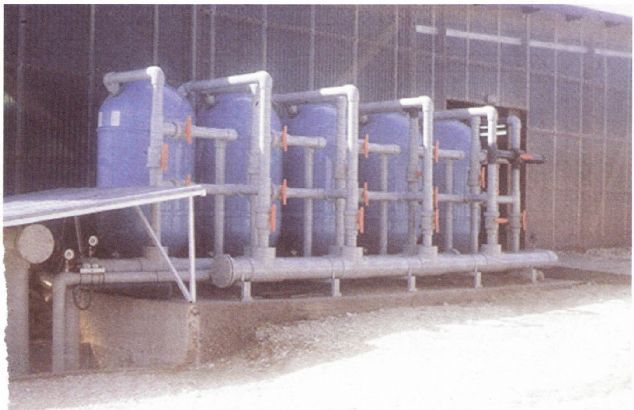 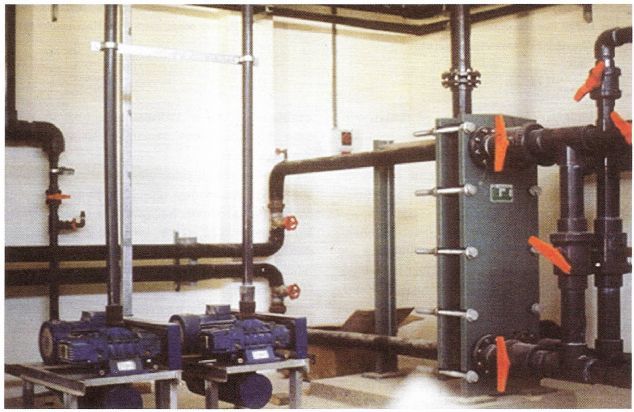 Top: Cleaning the sea water used in larva production by passing it through high pressure sand filters. Bottom: Temperature regulation in hatchery production facilities. (heat exchanger system)
PRELARVAL AND POSTLARVAL PERIOD
Sea bream prelarvae are approximately 2.6-2.8 mm in length when hatched. Vitellus sac diameters are 0.9-1 mm. There is a drop of oil 0.2-0.22 mm in diameter on the posterior part of the vitellus sac. Mouth and anus are closed. The head is small compared to the body, the eyes are large and without pigment. Pigmentation is yellow and black. Initially yellow pigments are found in a row in the anal and sides. The vitellus sac is surrounded by a waterproof membrane under the head. The pectoral fin is formed first horizontally and then vertically on the third day. Instead of the single fin, there is a primordial fin that starts on the top of the head and extends to the vitellus sac by wrapping the whole body. This fin expands the surface of the larva to stay above water and meet the need for oxygen. The otalites, which are the organs of balance, are behind the eyes and the nostrils are not fully developed. The digestive system is irregular and shaped like a straight tube. Pancreatic and liver organs have been formed, but there are no glands and lipid reserves. Most of the food sac is absorbed before the mouth is opened. The total increase in height in the prelarvae and the decrease in vitellus are closely related and are under the influence of temperature. Quickly consumed vitellus is not good for larvae growth, although it creates a sudden increase in height. When the vitellus is absorbed at low temperatures, the height increases late and the total dyeing becomes more. The low movement of the larva during this period reduces the energy consumption and the energy expended is used in the organelle development of the larva. At very low temperatures, deformations are seen in the body of the larva. In the larvae, the postlarval stage begins with the opening of the mouth and anus and the onset of color in the eyes. Air sac formation can be observed from the fourth day after the opening of the mouth and anus. The first stage of the normal development of the sac occurs when the larva is five days old and 4 mm tall. If swelling does not occur, the pouch preserves its primitive appearance but is not functional. The second stage of development occurs on the twentieth or twenty-second days, when the larva is about 7-8 mm tall. When the larva reaches 5-6 mm in height, thorns are seen on the anterior gill cover. Single fins are formed, 7-8 mm in length, first the tail, then the dorsal and anal. When it is 13 mm tall, the fins take their final shape. During this period, the melanophores accumulate to form horizontal, black bands all over the body.
SEA BREAM LARVA BREEDING PERIODS
When the eggs complete the embryological development and the larvae hatch, the larva breeding begins. Larvae breeding is done in modern hatcheries where biotic, abiotic and foreign biotic factors are taken under control.
LARVAL PERIOD Sea bream prelarvae are placed in tanks in an amount of 80-100 units / lt in intensive production conditions. Tanks are cylindrical-conical. It is made of polyester or fiberglass material. Their volumes can vary from 2 m3 to 15 m3. The selection of these tanks is related to the production capacity and the larva rearing technique to be applied. The water temperature is 16-18 degrees and the environment is dark. Oxygen value is 5-6 mg / lt. The water inlet is from the bottom and the outlet is from the top. In bream at 16-18 degrees water temperature, the prelarval period ends on the 3rd day and the postlarval period begins. Open circuit and closed circuit systems are used in sea bream larva breeding. In addition, green water technique based on the use of algae, also known as the English technique, is applied in different volumes. In open circuit systems, water criteria are adjusted according to the conditions required by the larvae and sent to the production tanks. When the green water technique is applied, the flow rates given to the tanks should be reduced. In the production with this technique in summer, the environment must be cooled to prevent the water in the tanks from heating due to low flow. Otherwise, algae spoilage disrupts the ammonia balance of the ambient water and causes mass deaths. Sea bream requires a very sensitive production work in the larval stage. Therefore, fluctuations in water changes are desired to be minimal. For this, it is necessary to use closed circuit systems in order to save energy and to increase production quality and quantity. In closed circuit system tanks, the water used by the larvae first comes to the collection tank. Here, after the required amount of fresh water is renewed, it is transferred to the sand filter for mechanical cleaning. Separated from the suspended particulate matter brought with it, the water is sent to the ultraviolet filter. The water passing through the ultraviolet filter is cleaned from all living organisms (bacteria, fungi, parasites, some viruses, etc.) and enters the biological filter. At this stage, aerobic bacteria can reduce the amount of ammonia that rises due to fish waste, feed waste and dead fish to a normal level. Ammonia is first reduced to nitrite and then to nitrate, which has no harmful effects for fish. The water that passes through these stages leaves the system to return to the pools. At the biological filter outlet, saturation columns should be used to increase the amount of oxygen in water falling down to 1.2-1.8 mg / lt to 5-6 mg / lt and to remove the excess nitrogen gas it brings. Ventilation systems can also be installed in the saturation belts. Ultraviolet filters are used after biological filters in the establishment of some closed circuit systems. However, the fact that pathogenic or non-pathogenic microorganisms that develop in the pools settle on the biological filters and replace the weak aerobic bacteria negatively affect the operation of the system. Closed loop systems are advantageous in terms of energy used in heating or cooling water. In addition, sudden fluctuations in the physical and chemical changes of water are very dangerous in closed circuit systems, especially when producing species that have a difficult larval stage such as sea bream. In closed circuit systems, the amount of ammonia should be checked by analyzing the water every day, otherwise sudden and massive deaths will be encountered.
The water temperature range used in sea bream larva breeding studies should vary between 18-22 degrees. The water temperature should be between 18-20 degrees in the first 15 days. The temperature is increased to 22 degrees after the 15th day and this temperature value is maintained until the end of the larval stage. The salinity reduction technique applied in sea bass larva breeding can also be applied in sea bream larvae breeding. Oxygen value is 5-6 mg / lt. Water intake is made from the bottom of the tank for the first 10 days and then from the tank surface. The larvae are kept in the dark until the postlarval stage when the mouth and anus open. In sea bream, the prelarval period ends on the 3rd day at 180 degrees water temperature and the postlarval period begins. In order to clean the oil layer accumulated on the tanks on the 2nd day, surface cleaners are placed in 1 or 2 pieces according to the width of the tank surface. This is very important for the first filling of the air bladder. Duration and intensity of enlightenment affect the development of larvae, air sac formation, and survival rate. The development of larvae increases under increased lighting conditions. Continuous lighting reduces the vitality of the fish. No lighting is applied to the larval tanks until the mouth is opened. Lighting duration and intensity are set to 3 lux on the third day, 30-50 lux on the fourth day, 600 lux on the fifth and tenth day, and 1500 lux on the eleventh day and beyond. The lighting period is 12 hours on the first day. Then, 24 hours of illumination is applied. It is not yet used in intensive production. The effect of larvae production on survival rates at 12-14 hours of lighting time and 30-32% salinity are still the research subjects that are being studied. Rotifers (Brachionus plicatilis) and artemia (Artemia sp) are used while the sea bream are fed by the larval stage. In addition, algae application is made to larval tanks. Algae application preserves the vitality of rotifers given to the environment and provides the pH balance of the environment. For this, algae of Chorella and Nannochloropsis sp can be used at a density of 5-7x105 cells per milliliter. Since the mouth opening of the sea bream is small (100 microns), small type rotifers should be used when feeding the larva. The sizes of these rotifers range from 40-80 microns. 15 pieces /ml between the third and fifth days, 10-12 pieces / ml between the fifth and twelfth days, 8-10 pieces / ml on the twelfth and tenth days, 6-8 pieces / ml on the fifteenth and twentieth days, the twentieth 4-6 units / ml between the 30th and 30th days and 2 units / ml between the thirtieth and thirty-fifth days should be fed with rotifer. The sea bream larvae reaches the size to be fed with Artemia naupli nearly after 15 days. Today, from 15th days larvea feed with snmalla artemia from San Francia bay. feeding is done with AF type artemia, which are used extensively in aquaculture facilities and produced by Artemia Systems. EG1 forms used in sea bass larvae are large in length (740-780 u) and width (225-240 u), so they are not used in larval stage of sea bream. Artemia nauplii is given as 0.5 units / ml between 15-20 days, 1 unit / ml between 20-25 days and then 2 units / ml until the 40th day. The success rate varies according to the breeding techniques applied at the end of the larval period. In the table on the previous page, the algae technique application is 480, the width is between 165-175 u and they contain more than 10 µg / gram HUFA. The protein ratio of the nauplii hatched varies between 48-52%, fat ratio 19.3-21%, carbohydrate ratio 12-13%, ash content 8.1-8.7% and moisture content 4.8-5.2%. EG type artemias used after the 30th day have a lower amount of protein (45-47%) and less unsaturated fatty acids (5-7 mg / g HUFA). In addition, they are larger in size. Their lengths are 500-520 p and their width is 175-190 p. Larval stage bream breeding protocol is given. SÖVRA] (Transition to Microparticle Feed) PERIOD After the completion of the larval period, between 40-42 days, the larvae are transferred to the jamb section where they will adapt from live feed to microparticle feed. In this section, which is used for the adaptation of larvae, whose larval breeding is finished at the end of 40 days, to mixed feeds, 10-15 m3 tanks are used in a number determined according to the capacity of the enterprise. Bottoms of the tanks are conical and cylindrical. It is important that the tanks are well designed and have sufficient volume in terms of ensuring the position of the fish in the tank, the distribution of feed in the tank, feed intake and water circulation. The inner part of the tanks is covered with gel coat, which prevents colonization of microorganisms on the surface. The jamb sections are also operated by establishing a closed circuit system, if desired. In this system, there are problems with excessive water flow, the rapid deterioration of the water quality of the feed used, the increase in the rate of nitrogenous compounds produced by the larvae, and the increased risk of disease. Therefore, open circuit systems are preferred in many facilities. Water outlets are from the center and the bottom. Depending on the age of the fish, the eye apertures of the crepes placed in the water outlets vary between 500p, 1.000p and 2.000p. 1,500-2,000 lux lighting is applied in the pools. The illumination duration of the unit is 16 hours and is adjusted automatically with the help of timers. The period of acclimation to the microparticle feed starts in 40-42 days when the fish reach 25-30 mg of weight. During this period, the fish density in the ponds is 10-12 per liter. In cases where pure oxygen is used, this rate may rise up to 18-20 units / lt. During this period, artemia used in feeding should be enriched in terms of HUFA. For this, EG type artemia nauplii are grown by feeding them with SELCO derived enrichment agents for 24 hours. Enriching products with high content: HUFA (200 mg / gr), vitamins, antioxidants and oil (60-65%). The size of the artemias that come to the form of metanauplii at the end of 24 hours varies between 740- 780 u and their width between 225-240 p. Microparticle feeds used during jamming should contain 56-64% crude protein, 11-12% crude oil, 11.4-11.7% ash, 1.4% crude fiber, 10% moisture and sufficient amounts of vitamin-mineral substance. Microparticle feeds are used in direct proportion to larval development, starting from 80 microns in size. Sea bream can adapt to microparticle feed faster than sea bass. The jamb application continues for 10-12 days. The daily amount of artemia given to the larvae is reduced and the rate of microparticle feed is increased. Feeding rate during this period is between 8-10%. Since the sea bream has an extreme cannibalistic feature, there must be enough feed in the environment and the fish must be graded continuously. The weight of the larvae preparing to leave the jamb section reaches 300-350 milligrams. During the jamb, the water temperature is 20-22 degrees and the water flow rate in the tanks varies between 50-100% per hour. Sea bream adapts to the jamb period quicker and faster. Larva survival rate is between 85-95%, depending on the success of the jamb. The fish that complete the jamb are taken to the pre-growth unit and adapted to the natural sea water environment from here.
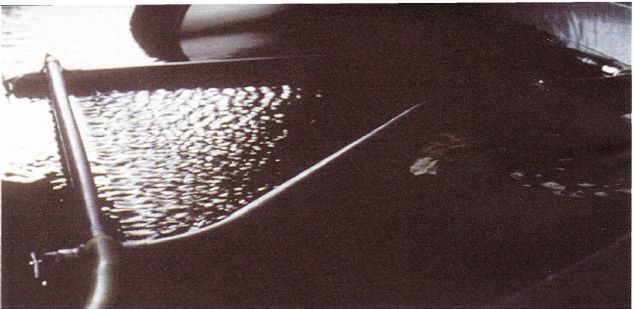 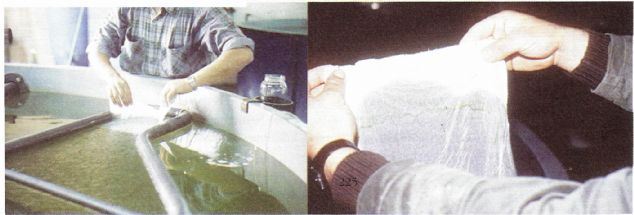 Top: During the larva production period, the tanks are cleaned by spraying air to remove the dirt and oil layer formed on the surface. Bottom: The process of cleaning the air brooms and the oily dirt seen on the cloth.
PRE-ENLARGEMENT The tank features used in the front enlargement unit are the same as the jamb section. Open circuit water system is used in this section. Puppies that leave the jamb unit between 60-70 days according to their developmental characteristics are transferred to the pre-growth unit after separating according to their height. In addition, individuals with and without air sacs are distinguished from each other during height classification. In this section, they are grown up to 1.5-2 grams in weight to be taken into mesh cages. However, under the conditions of our country, juvenile individuals are taken into cage systems when they are between 0.5-1 grams. In the pre-enlargement unit, the fish should be observed continuously and classification should be made according to their lengths frequently to prevent cannibalism. The water temperature given to the fish is 20-22 degrees and lighting is applied for 16 hours. Feed is made with automatic feeders. Natural sea water salinity is used in the tanks. 3.000- 5.000 pieces / lt fry can be stocked in the tanks. Water change varies between 50-150% per hour depending on fish size and stocking density. Feeding rate starts with 7% and decreases to 3%. The survival rate is between 90-95% during the period when the disease does not occur.
MAGNIFICATION Sea bream juveniles obtained from hatcheries and natural environment are raised by using different techniques in rearing systems established in land and sea environments to be brought to a portion size. Among these, semi-intensive and intensive breeding methods are the most used. The extensive method currently used in our country is not at the level in European countries. Especially in Bodrum and Savran regions, there are sea bream enterprises that make semi-intensive production. EXTENSIVE BREEDING METHOD For this, the open sea, coastal lagoons and brackish water bodies connected to the sea are used. In the lagoon areas in the coastal zone, species such as sea bass, gray mullet and eel, especially sea bream, are also grown. Cubs enter the kiddles to shelter and feed in the spring season. During this period, they feed on many zooplankton and phytoplankton as well as small fish, shrimp juveniles, mammoths, sulines, mussels and akivades. The sea bream, which weighs 2-10 grams in the İzmir closed regions, reaches 80-120 grams in the autumn season. Those who weigh 100 grams can reach up to 200-300 grams. These weight gains are related to the productivity of the kiddle. Sea bream tends to escape into the warmer deeper waters with the cooling of the kiddle area towards the winter months. Individuals caught from lamb systems installed at points connected to the sea can be put on the market. They can also be caught alive and grown in soil pool and net cage systems. There is no need for nutrition and control of environmental conditions in extensive cultivation. However, these areas can be deepened by parceling and water exchange can be provided. In this technique, which is intensely called valiculture, especially on the Italian coast, nutritional supplements are made from outside. These systems are also supplemented with offspring from outside. In extensive lagoon cultivation, 100-500 kg / hectare of product can be obtained in a year, depending on the species, in 80-100.000 hectares of land.
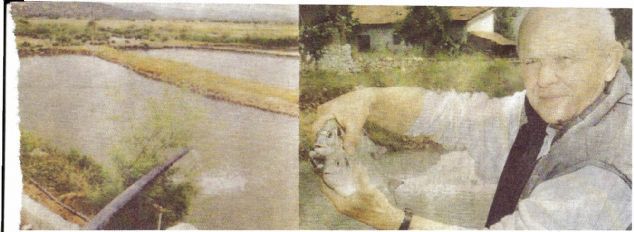 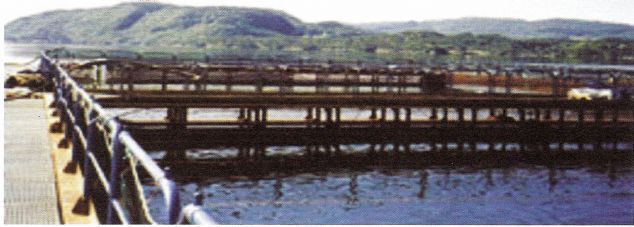 Top: A news in the Hürriyet newspaper. Fish abundance in the field. They said crazy, he was the savior. Cemal Metin, who grows fish in the field in Milas district of Muğla, successfully produced sea bream and sea bass in earthen ponds. Upon this successful application in the Savran village of Milas, 150 pools were opened in the village and fish started to be grown in salty spring water. This production is an example of saline groundwater can be used for fish farming. Today, marine fish farming in earthen ponds is practiced in many places in our country. Bottom: Sea bream breeding in net cages is a matter of 20-25 years. In 2012, nearly 40 thousand tons of production was made.
SEMI-INTENSIVE GROWING METHOD
This system is also called pond cultivation. It is generally used for breeding fish and arthropods. In addition to soil and concrete pools, portable pools made of polyester or polymer material are also used. In addition, production can be made by encircling coastal areas with a net. In these systems, daily water changes are under control and oxygenators are used to increase the amount of product. In earthen ponds, geo-membrane system has been used in recent years. It can also be used for intensive purposes by increasing the stock density depending on the increase of the water flow. However, the problems that may occur in the system affect the production negatively. Therefore, it is beneficial to keep the stocking density low. The stock density is between 2-5 kg / m '' in concrete pools, tarpaulin pools and small volume soil pools covered with geo-membrane inside. 1-4 tons / hectare of product can be obtained from large earthen ponds.
INTENSIVE CULTIVATION METHOD This method is used extensively in the world and in our country. With this method, aquaculture can be done in floating net cage systems. In parallel with the development of aquaculture studies, aquaculture systems have been developed since it provides more efficiency per unit area. Today, systems that can be installed safely in coastal areas, open seas and oceans are planned. Today, 150 tons of production can be made per year in a single system in offshore cages with volumes varying between 2,500-6,000 m3. These systems are more attractive due to features such as better water quality compared to coastal regions, less pollution effect of the enterprise on itself and others, more intense stocking per unit area, faster fish development, long-term economic and high capacity fish stocking. Fixed cages, floating cages, submersible cages and rotating cages are used in cage systems. In the net cages, 15-30 kg / m can be stocked depending on the characteristics of the place where it is installed and the condition of the water quality. Feeding techniques and water temperature play an important role in the rapid development of fish. In addition to feed quality, the relationship between fish weight and water temperature should be followed carefully in feeding regimes. The values in the feeds used in this period: protein 46-52%, cellulose 2-4%, crude ash 12-13%, crude fat 10-11%, calcium 1.4-2.2% and phosphorus 1.15-15%. In addition, vitamins and trace elements should be used in sufficient amounts. In the table below, the feeding rates of the bream fish at 16-25 degrees according to their weight and the mesh openings where the fish should be placed are given. Using knotless nets in cages is beneficial for preventing gill entanglement, exfoliation and scratches on the body.
Sea bream juveniles, which spend 4 months in aquaculture facilities under the conditions of the Aegean Region, reach a weight of 350-400 grams from 3-4 grams in 12-14 months after they come out in net cages. This time and weight increase may vary depending on the ecological conditions of the growing environment, the content of feed used, fish stock density, disease factors and larva quality.
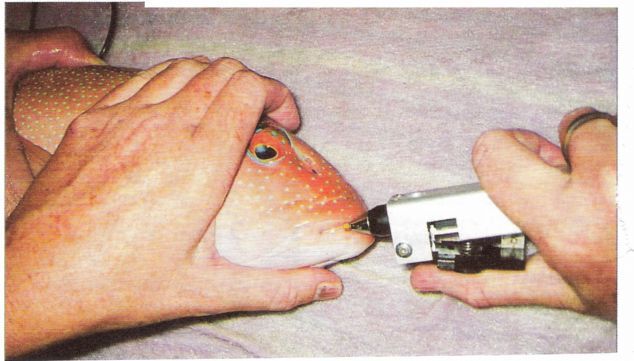 In recent years, great importance has been given to breeding studies in marine fish farming. The main goal is to breed high-skilled breeders and produce offspring from them. For this purpose, it is very important to identify and number the fish to be used in breeding. In the past, various methods such as cutting the fins etc. had been tried in the numbering of the fish. Today, this is easily achieved thanks to microchips placed on the bodies of fish.
EXTENSIVE BREEDING METHOD For this, the open sea, coastal lagoons and brackish water bodies connected to the sea are used. In the lagoon areas in the coastal region, species such as sea bream, sea bass, gray mullet and eel are grown. The cubs enter the kiddle areas to shelter and feed in the spring season. During this period, they feed on many 200 and phytoplankton as well as small fish, shrimp juveniles, mammoths, sulines, mussels and akivades. The sea bream entering the kiddles in the Izmir Bay region, while they weigh 2-10 grams, reach 80-120 grams in the autumn season. Those who weigh 100 grams can reach up to 200-300 grams. These weight gains are related to the productivity of the kiddle. The sea bream is caught in the lambs because they want to leave the kiddle due to the cooling of the kiddle towards the winter months. Thus, production is ensured. You can find detailed information about kiddle in the mullet section.
RESULT In sea bream larva breeding, the desired survival rates have not been achieved today. Sufficient number of offspring production can be achieved successfully in many hatcheries. It is expected that more successful results can be obtained in the future. Important criteria for increasing the success rate of sea bream that require a very difficult and sensitive production technique: · Continuous control of the physico-chemical structure of the ambient water · Avoiding sudden changes · Creating environments free from pesticides, metallic ions, hypochlorite and other contaminants while procuring eggs · Paying attention to hormone applications · Disinfecting live eggs before incubation process · Keeping the egg and larva stock density at optimum ratios · Avoiding sudden abiotic changes and mechanical shocks · Very fine adjustment of light intensity in the larval stage · Before the postlarval period, the oil layer accumulated on the tank surface is calculated and removed by air brooms by calculating the surface area. · If the survival rate of some larva tanks is lower than other tanks without changing the ambient conditions between 12-14 days, these tanks should be canceled by chlorination. · No sudden changes in water conditions and environment during the development of the bladder. · Enrichment of rotifera (Brachionus plicati! Is) and Artemia (Artemia sp.), Which are live food sources given to larvae, with essential fatty acids and vitamins · Increasing the flow rate applied to the larval tanks in direct proportion to the age of the larva · Taking larval velocity and resistance into consideration in making flow rate calculations · Separation of the larvae deformed between 70-80 days due to the non-functional air sac. · Separation techniques must be done before the pups are sent to the net cages. · Taking necessary precautions against disease factors · The use of feeds with high nutritional value in jamb, pre-growing and growing periods.
Even if all these conditions are tried to be fulfilled, different problems will be encountered in various stages of production. Quality and quantity will increase day by day thanks to the follow-up of the production techniques developed and their adaptation to the conditions of our country. A few more species known as "sea bream" in English have been bred and some information on this is presented below.
SILVER BREW (Sparus sarpa) It is known as "Silver sea bream" in English. It is a species that ranks 6th among marine fish farmed in the world with 72,000 tons according to 2002 data. It is reported that around 10 million larvae are produced in 38 hatcheries in Taiwan and they are fattened in net cages. It is a species common from the Sino-Japanese Sea to the Red Sea. It is also found off the coasts of South Africa and Australia. It is known as a very high quality fish.
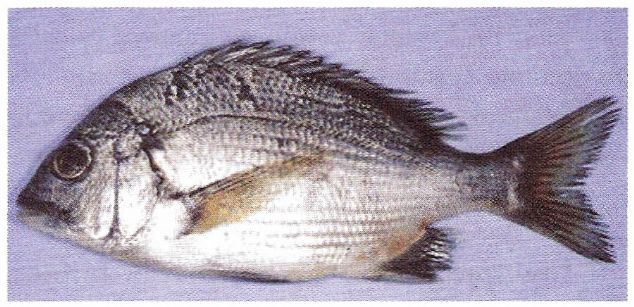 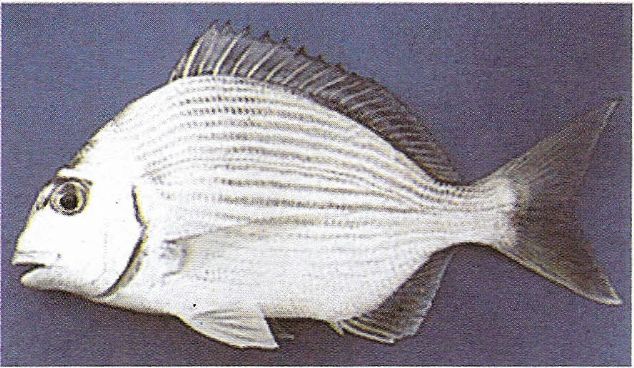 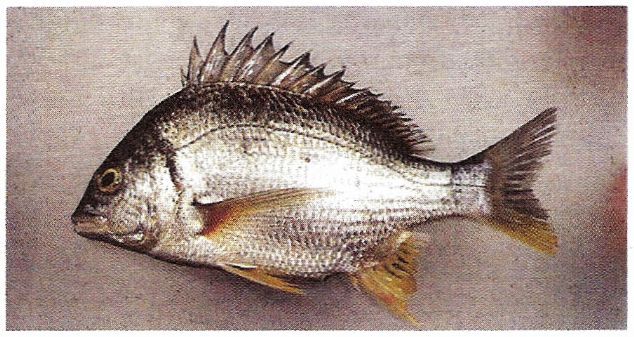 Top: Black Sea Bream (Acanthopagrus schlegeli) Medium: Silver Sea Bream (Sparus sarba) Bottom: Japanese Silver Sea Bream (Acanthopagrus latus)
BLACK SEA BREAM
It is known as "Black sea bream" in English. Black sea bream is a species that is cultivated in Taiwan and Japan. The amount of this species caught from nature is around 3,500 tons. It is a species that is resistant to cold water environments. It can withstand temperatures up to 10 degrees, although it is also common in equatorial regions. Farming, which is also done through offspring production, is practiced in Japan. It was recorded that around 15 million juvenile fish were raised in Taiwan in 2002.
JAPANESE SILVER SEA BREAM (Acanthopagrus latus) It is included in the Speridae family. It is a species that is cultivated in Japan, Taiwan and some countries. In these regions, this species is also given great importance in terms of angling. It can reach 45 cm in length and 4 kg in weight. Also known as "Japanese Silver Sea Bream" and "Yellowfin Sea Bream" in English.
|




